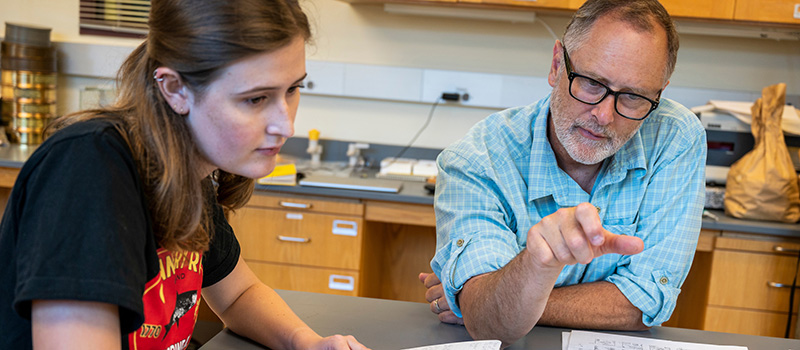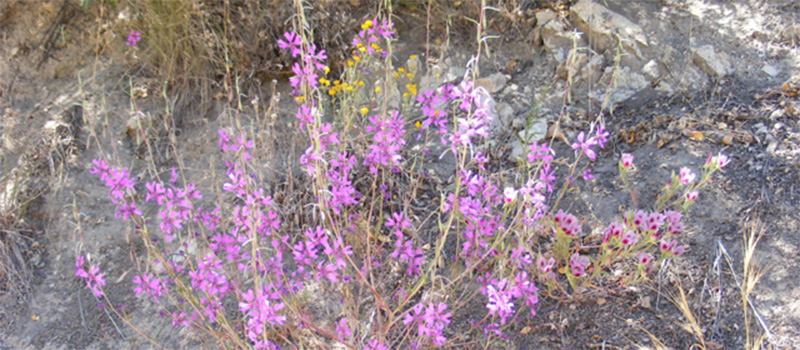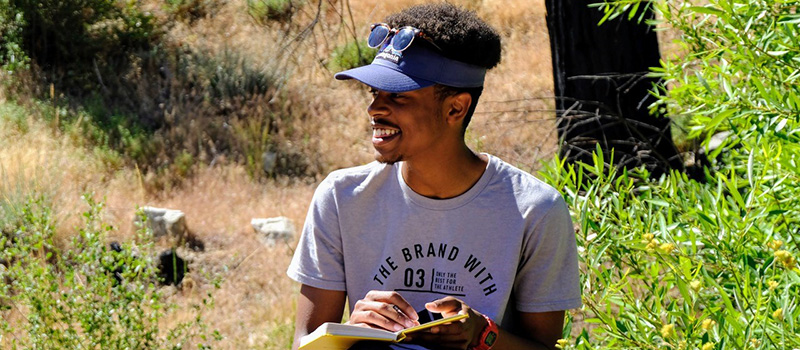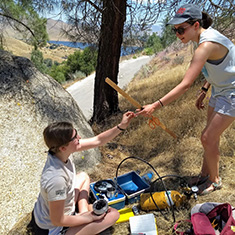Grinnell students gain field study experience thanks to long-term National Science Foundation grant
October 04, 2023 — When the wildflower Clarkia xantiana starts blooming each year at the southern end of the Sierra Nevada mountains, it’s a signal that spring is ending in California.
“It’s about the last of the wildflowers that you’ll see as summer begins,” says Professor Vincent M. Eckhart, Waldo S. Walker Professor of Biology. Eckhart’s a California native who has studied the flower for decades, and most summers he brings Grinnell students to the Golden State for field studies.
 In this summer 2019 photo, Rachel Snodgrass ’21, left, and Vince Eckhart, Waldo S. Walker Professor of Biology, discuss their research after returning from California.
In this summer 2019 photo, Rachel Snodgrass ’21, left, and Vince Eckhart, Waldo S. Walker Professor of Biology, discuss their research after returning from California.
For the past five years Eckhart’s studies, along with his colleagues Monica Geber, professor emerita at Cornell University; and David Moeller, a professor at the University of Minnesota, were funded by a $450,000 National Science Foundation Long-Term Research in Evolutionary Biology Grant. It’s a continuation of a previous five-year grant to Eckhart and his fellow investigators.
Running from 2018-23, the project is called “Evolutionary demography – the contribution of adaptation and environment to population dynamics, range size, and niche width.” Or as Eckhart explains: “Species have geographic range limits – they don’t occur everywhere – and that deserves some explanation. Why do they occur where they do and not somewhere else?”
Usually a half meter to a meter tall, Clarkia xantiana sports three-to-four centimeter wide pink flowers that have four, heart-shaped petals in a cross shape. Between each petal is a little “gunsight” (point), and some petals on some individual plants have deep red spots near their base.
 The flower Clarkia xantiana starts blooming each year at the southern end of the Sierra Nevada mountains.
The flower Clarkia xantiana starts blooming each year at the southern end of the Sierra Nevada mountains.
Clarkia xantiana is convenient to study because it has a reasonably small distribution, it’s not threatened with extinction, and it’s located mainly in a 50x60 kilometer rectangle near the Sierra Nevada’s south end.
Typically two Grinnell students head west with Eckhart each summer for three to five weeks through Mentored Advanced Projects (MAPs). He’s been taking students most years since 1997, his first summer as a Grinnell professor. The two students serve as each other’s field/lab assistants while working on different projects related to the main project. Students then return to Grinnell to analyze data and write papers and presentations.
In summer 2018, biology major Sean Wright ’20 determined ways in which Clarkia xantiana and three other species within the genus Clarkia vary in drought tolerance by studying their root development and associations with soil fungi. Following the completion of a research paper and poster, Wright presented his findings at the National Science Foundation’s LSAMP Inspire conference, where he received a first-place prize in research posters.
 Sean Wright ’20 is pictured in the field while doing research for his MAP in the summer of 2018.
Sean Wright ’20 is pictured in the field while doing research for his MAP in the summer of 2018.
In 2019, Anchalee “Sara” Tantiviramanond ’20 estimated how flower color and associated chemical composition affects the risk of plant damage from insects and small mammals. Plants with spotted petals (and more tannin) receive less damage. Her field partner Rachel Snodgrass ’21 studied water physiology of the plants, looking at soil moisture and plant water status of plants at different distances from near boulders and shrubs. Boulders shed water, providing locally favorable spots for Clarkia xantiana during the flowering season, while shrubs provide wet refuges for winter seedlings but compete for water with Clarkia in the flowering season.
Rachel went on to work in ecological restoration and outreach at a natural area in California as stewardship coordinator of the Putah Creek Council. She is getting ready to move to Spain with her partner where she will teach English. Sara had a wildlife ecology internship last year with the New Mexico Department of Game and Fish. She spent the past five months as a kayak guide in Sitka, Alaska, and is also heading soon to Spain where she plans to complete a dive master program on Gran Canaria island (along with visiting Rachel).
 Anchalee “Sara” Tantiviramanond ’20
Anchalee “Sara” Tantiviramanond ’20
and Rachel Snodgrass ’21
Over the longer term, 15 students have published papers based on their research with Eckhart. “Sometimes I’ll notice that work done by different students over a span of five years tells a story that can be published,” says Eckhart, who puts together those sorts of papers as lead author. “In 2017 we published a paper that had five student co-authors who graduated in 2008, 2011, 2014, and 2016.” Other student MAPs tell reasonably complete stories by themselves, leading to publications with students as first authors.
Besides published papers, students work with a tremendous amount of climate and other data and learn statistical modeling. Many learn to use Geographic Information Systems (GIS), computer software to analyze and display geographically referenced information such as plant population locations, climate, and topography.
Other skills gained, says Eckhart, include on-the-ground problem solving when doing field research. “There are decisions you must make in sampling. If there’s a wildfire and a site burns, for example, you need to make spur-of-the-moment decisions, and be flexible and resourceful.” And of course, students have to write up their work, using primary literature and research to communicate clearly and put the work in context.
Students who’ve studied the pink wildflower have gone on to a range of academic and professional work, from graduate degrees in wildlife biology and science communications, to working as field biologists for state government and conservation organizations. At least four former students went on to become college biology professors, some are physicians, and quite a few are professional scientists. Among the students who worked on the latest grant who have gone on to work in science are Daphne Bloom ’19, Anna Pulak ’19, Will Bebee ’22, Bjorn Larson ’22, and Isabella Vergara ’23.
 Aidan Healey ’17 completed a MAP about Clarkia xantiana during the summer of 2016.
Aidan Healey ’17 completed a MAP about Clarkia xantiana during the summer of 2016.
The most recent student research from the past five years will also reach the local Grinnell community. In his NSF grant, Eckhart proposed the idea of Market Science. The idea (borrowed from the University of Minnesota, which did this at St. Paul Farmer’s Market) is that students will have a booth at the Grinnell Farmers Market to talk about, demonstrate, and share their research.
“We’d have a rotating cast of people from labs at the College,” says Eckhart, who’s aiming at summer 2024 for the booth.
At the end of this five-year grant – which was extended for one more year – the work will continue, says Eckhart. “Though we’ll submit a final report, we have the support here at Grinnell to continue to think about things, and though I’ll retire in 5-10 years, the curiosity continues. The real resource that renews itself are the Grinnell students, who bring these ideas to new students, who go off and do similar or different things. The research is continually renewing.”
— by Anne Stein ’84